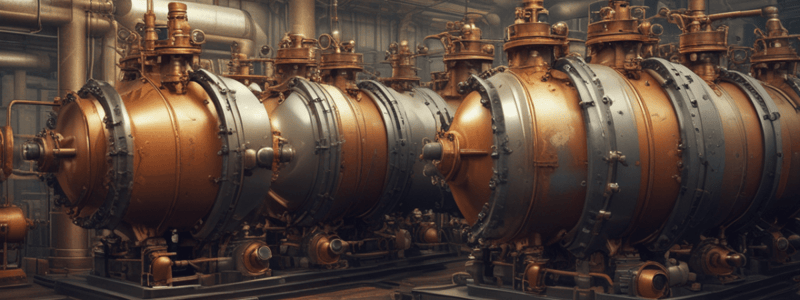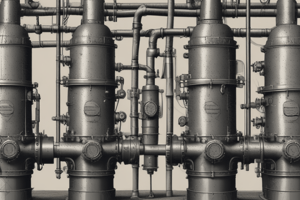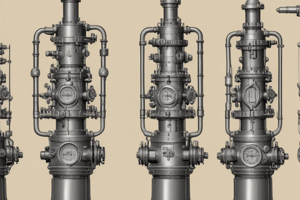Podcast
Questions and Answers
What is the primary purpose of a try lever test on a pressure relief valve?
What is the primary purpose of a try lever test on a pressure relief valve?
- To perform a full operation check of the safety valve
- To determine if the valve will open at its set pressure
- To check if the valve is operating freely (correct)
- To record the opening and reseating pressures of the valve
How often should try lever tests be performed on power boilers that operate below 2760 kPa?
How often should try lever tests be performed on power boilers that operate below 2760 kPa?
- Every month
- Every three months
- Every year
- Every six months (correct)
What is the minimum steam pressure required to perform a try lever test on a steam heating boiler?
What is the minimum steam pressure required to perform a try lever test on a steam heating boiler?
- 20 kPa
- 30 kPa
- 40 kPa
- 35 kPa (correct)
What is the purpose of the pop test on a pressure relief valve?
What is the purpose of the pop test on a pressure relief valve?
How often should pop tests be performed on a pressure relief valve?
How often should pop tests be performed on a pressure relief valve?
What should be done if the valve simmers after a try lever test?
What should be done if the valve simmers after a try lever test?
What is the minimum pressure required to perform a try lever test on a power boiler?
What is the minimum pressure required to perform a try lever test on a power boiler?
What should be accurately recorded during a pop test?
What should be accurately recorded during a pop test?
Flashcards are hidden until you start studying
Study Notes
Pressure Relief Valve Maintenance
- Pressure relief valves must be kept in good working condition at all times and tested regularly to ensure proper functioning.
Try Lever Test
- The try lever test determines if a pressure relief valve is operating freely, but not if it will open at its set pressure.
- The test is performed:
- Monthly on steam heating boilers
- Every three months for hot water heating boilers
- Every six months on power boilers operating below 2760 kPa
- Prior to pop tests and accumulation tests
- Boiler pressure must be:
- 35 kPa or higher for steam heating boilers
- At least 75% of the safety valve setting for power boilers
- The test procedure:
- Pull the try lever to the wide-open position
- Allow steam to discharge for 5-10 seconds
- Release the lever
- Allow the spring to snap the valve disc to the closed position
- If the valve simmers, operate the try lever 2-3 times to allow the disc to seat properly
Pop Test
- The pop test checks the full operation of the safety valve, including the exact pressures at which it opens and closes.
- The test procedure:
- Increase the boiler steam pressure to the safety valve set point
- Record the opening and reseating pressures accurately
- Compare the opening pressure and blowdown to the ASME BPVC performance tolerances
- The pop test should be performed annually, before taking a boiler off-line for maintenance.
- Defective valves can be identified and replaced or repaired prior to the boiler re-entering service.
Repair and Adjustment
- Repair or adjustment of pressure relief valves must be done by the valve manufacturer or its authorized repair representative.
- Consult the relevant ASME BPVC sections and the local Boiler Inspector to determine who is qualified to adjust or repair PRVs in a particular jurisdiction.
Studying That Suits You
Use AI to generate personalized quizzes and flashcards to suit your learning preferences.




